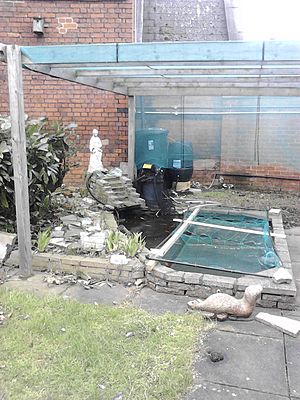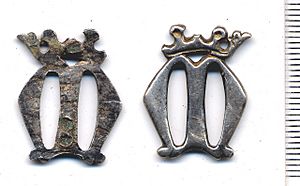Our Lady of Ipswich facts for kids
Our Lady of Ipswich (also known as Our Lady of Grace) was a very important place where people went to pray to the Virgin Mary a long time ago in England. It was like a special church or holy spot. Among all the places dedicated to Mary, only the shrine at Walsingham attracted more visitors.
Contents
England's Special Connection to Mary
For hundreds of years, England has been called 'Our Lady's Dowry'. This means it was seen as a special gift or place for the Virgin Mary. Even in Anglo-Saxon times, many shrines were built for Mary across England.
By the High Middle Ages, which was a period from about 1000 to 1300 AD, there were many places dedicated to Mary. In Suffolk, where Ipswich is located, there were sixteen shrines just for Mary! Many churches in Suffolk were also named after St Mary. Even churches not named after her usually had a special place inside for a Marian shrine.
Some of these shrines became so popular that they needed their own buildings. This is likely how the shrine of Our Lady of Grace in Ipswich became so famous. During the High Middle Ages, it was the second most visited Marian shrine in England, after Our Lady of Walsingham.
History of the Shrine
The town of Ipswich was a busy port long ago, known for trade and building ships. Many people, including pilgrims visiting the shrine, filled the town's inns and taverns. The shrine to Our Lady of Grace in Ipswich was first mentioned in records around 1152.
The shrine was located on Lady Lane, just outside the old town wall of Ipswich. Today, a plaque and a statue mark the spot. In 1297, King Edward I's daughter, Princess Elizabeth, even got married there.
Many important people visited the shrine over the years. For example, Sir John Howard, a very wealthy and powerful man, visited several times in the late 1400s. He made offerings each time he came to pray.
Later, King Henry VII's wife, Elizabeth of York, gave a donation to the shrine in 1502. Between 1517 and 1522, King Henry VIII and Queen Catherine of Aragon also visited separately. Famous figures like Sir Thomas More and Cardinal Thomas Wolsey, who was born in Ipswich, also came to the shrine.
A Special Healing Story
The statue of the Virgin Mary at Ipswich became famous because people believed it had a miraculous power to heal. Sir Thomas More wrote about one such miracle in his book The Supplication of Souls. He said he heard the story directly from someone who saw it happen.
The miracle involved a 12-year-old girl named Anne Wentworth. She was the daughter of Sir Roger Wentworth, a friend of Sir Thomas More. Anne suffered from seizures where she would spasm and speak strangely. After seeing a vision of Our Lady of Grace at Ipswich, she was taken to the shrine.
She was laid before the statue, still suffering greatly. But right there, in front of everyone, she was suddenly and completely healed! Anne was so thankful for this miracle that she later became a nun.
The Shrine's End
The shrine was closed down during the English Reformation. This was a time in the 1500s when big changes happened in England's religious practices. The statue from Ipswich was taken to Chelsea to be burned, along with the statue from Our Lady of Walsingham, on September 20, 1538.
While there are no direct eyewitness accounts of the statue actually burning, records show it did arrive in Chelsea. Thomas Cromwell's steward wrote to him, confirming he had received the statue. He noted that it had "nothing about her but two half shoes of silver."
Even though the shrine itself was destroyed, it was still mentioned in old legal documents as a landmark until the 1700s.
The Statue in Italy
Amazingly, a wooden statue of the Madonna and Child in Nettuno, a seaside town in Italy, looks very much like descriptions of the Ipswich statue. Locals call it "Our Lady of Grace" or "The English Lady." Scientists have tested the wood, and it shows the tree was cut down between 1280 and 1420.
There are also records in Nettuno that a statue arrived there from Ipswich in 1550. An expert in old religious art, Martin Gillett, said in 1938 that the statue was in the English style from the 1200s. Even though parts of the statue had been changed, details like the way the clothes are carved and the position of the Christ child suggest it came from England.
During World War II, the Nettuno statue was moved to Rome for safety during the Battle of Anzio.
In 1959, during restoration work, an inscription was found on the back of the statue. It said IU? ARET GRATIOSUS, which means "Thou art gracious." Ipswich was the only Marian shrine in England dedicated to "Our Lady of Grace." Even more interesting, when Martin Gillett first saw the statue in 1938, it was wearing two half shoes made of English silver. This matches exactly what Thomas Cromwell's steward described 400 years earlier!
There are two ideas about how the statue got to Italy. One is that an English official, perhaps Thomas Cromwell, sold it instead of burning it. Another story, popular in Nettuno, says that English sailors saved the statue before it could be burned. They smuggled it onto their ship. In the Mediterranean Sea, they ran into a storm and found shelter in Nettuno, where they donated the statue. Scientific tests on a small piece of wood from the statue's base show a lot of salt, suggesting it was once in contact with seawater.
Every year in Nettuno, thousands of people watch as the statue is taken from its place above the altar. Dressed in beautiful clothes, it is carried in a big parade through the streets for a week-long stay at another church. A copy of the statue was given to Pope Benedict XVI in Rome in 2010.
Modern Efforts to Restore the Shrine

Today, a modern shrine exists in the Anglican church of Saint Mary Elms in Ipswich. This church is not far from where the original medieval shrine stood.
In 1987, a group called the Guild of Our Lady of Ipswich was started. People from both the Catholic church of St Pancras and the Anglican church of St Mary at the Elms joined. Their goals are to pray for Christian unity and to bring back the shrine of Our Lady of Grace in Ipswich.
On September 10, 2002, a new wooden copy of the Italian statue was blessed and placed in the Anglican church of Saint Mary at the Elms. This statue was carved by Robert Mellamphy. Important religious leaders from different Christian churches attended the ceremony.
In 2022, the Catholic church of St Pancras in Ipswich ordered a very close copy of the Nettuno statue from Italy. This new statue is 120cm tall and sits on a throne. It arrived in June 2023. The statue shows Mary wearing a red gown and a blue cloak. It has golden stars and a lily, symbolizing different aspects of Mary. Her right hand holds the baby Jesus, while her left hand offers Him an apple. This statue tells the story of human salvation. For the first time since 1538, a Catholic church in Ipswich now has a special statue of Our Lady of Ipswich for people to pray to.
See also
- Religion in the United Kingdom
- Anglican Marian theology
- Our Lady of Walsingham
- Our Lady of Willesden
- Our Lady of Westminster
- Our Lady of Doncaster
- Our Lady of Cardigan



